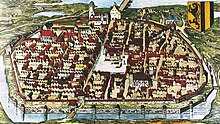Zwinger (Dresden)
Its richly decorated pavilions and the galleries lined with balustrades, figures and vases testify to the splendor during the reign of Augustus the Strong, Elector of Saxony and elected King of Poland.
The plans for a new castle were abandoned after the death of Augustus the Strong, and with the departure from the Baroque period, the Zwinger initially lost importance.
The original intended use as an orangery, garden and as a representative festival area has taken a back seat; the latter continues to be cultivated with the performance of music and theater events.
The Zwinger is bounded by Sophienstraße in the southeast, Postplatz in the south, Ostra-Allee in the southwest, the Am Zwingerteich road in the northwest and Theatre Square (Theaterplatz) in the east.
Nearby buildings include the Dresden State Theatre to the southwest, the Haus am Zwinger to the south, the Taschenbergpalais hotel to the southeast, the west wing of the palace with its Green Vault to the east, the Altstädtische Hauptwache to the northeast, the Semper Opera to the north and the former royal stables to the northwest.
Within view lie the Catholic Court Church and the Italian Village in Theatre Square, the Wilsdruffer Kubus on Postplatz and the Duchess Garden with the remnants of the former orangery building in the west.
The area between the two walls was generally referred to as the Zwinger and, in the vicinity of the castle, was utilised by the royal court at Dresden for garden purposes.
In 1569, major work began on redevelopment and new buildings by the fortifications west of the castle based on plans by master builder, Rochus Quirin, Count of Lynar, who came from Florence.
[4] Augustus the Strong returned from a grand tour through France and Italy in 1687–89, just at the moment that Louis XIV moved his court to Versailles.
The Zwinger was formally inaugurated in 1719, on the occasion of the electoral prince Frederick August's marriage to the daughter of the Habsburg emperor, the Archduchess Maria Josepha.
Later the plans were changed to a smaller scale, and in 1847–1855 the area was closed by the construction of the gallery wing now separating the Zwinger from the Theatre Square.






